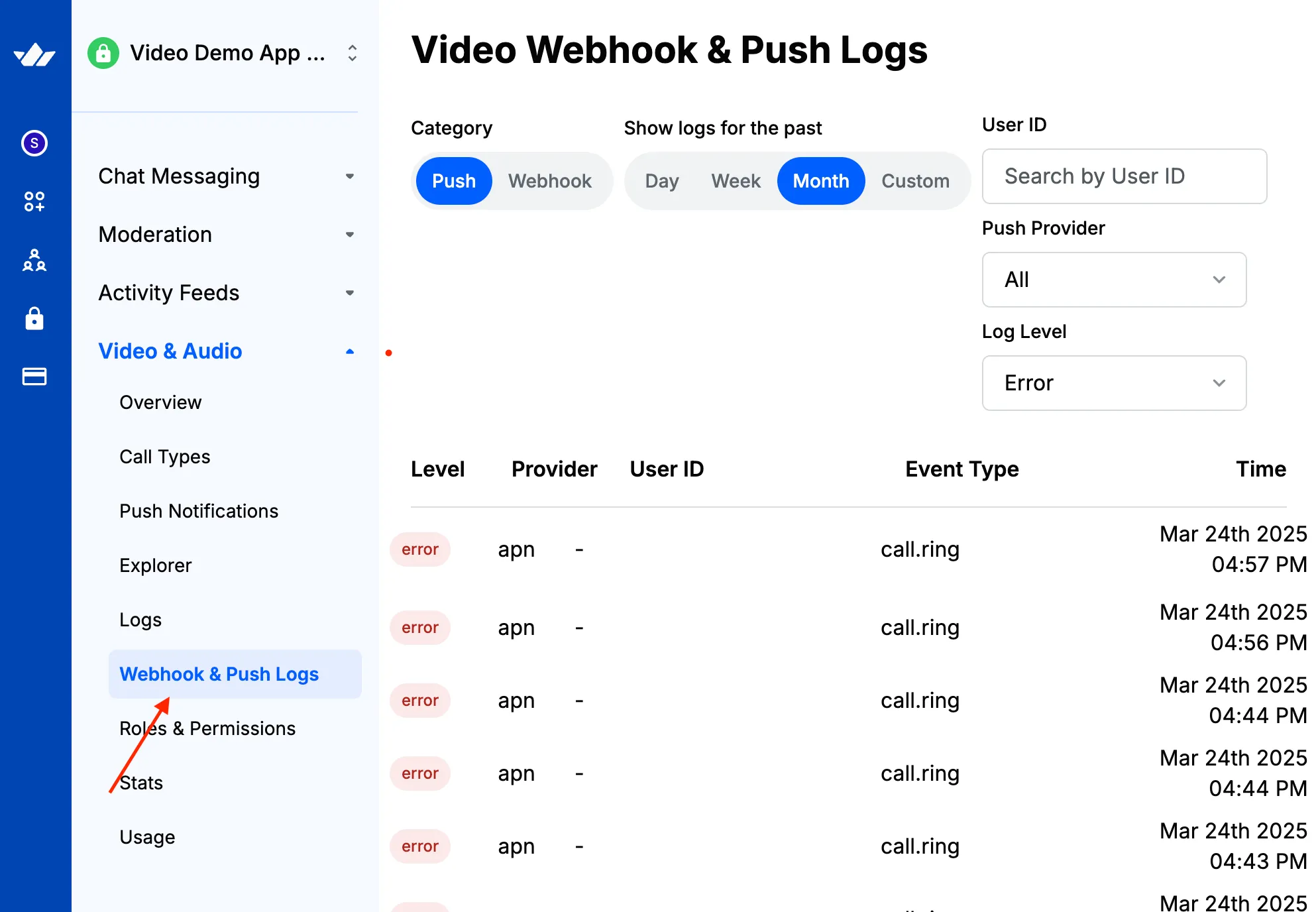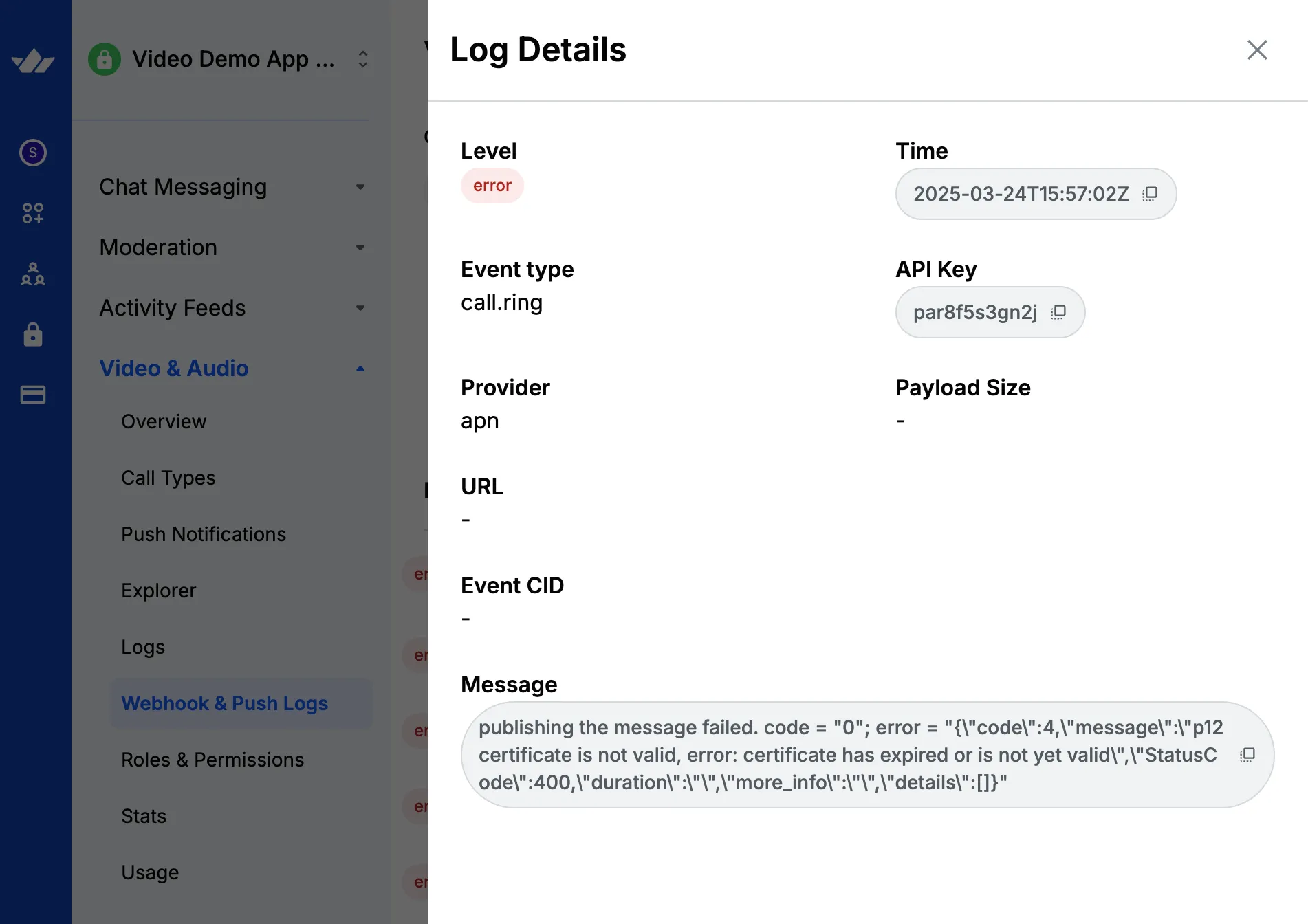try {
await call.join();
} catch (err) {
setError(err); // handle error
}Troubleshooting
There are several possible integration issues that can lead to calls not being established. This section will cover the most frequent ones.
Connection issues
Connection issues usually happen when you provide an invalid token during the SDK setup. When this happens, a web socket connection can’t be established with our backend, resulting in errors when trying to connect to a call. Network issues and firewalls can also prevent connection from establishing. To handle these errors, make sure to handle rejections of the call.join() promise:
Before call.join() rejects, a maximum of three attempts will be made to connect to a call with exponential backoff. This behavior can be customized or disabled:
try {
await call.join({ maxJoinRetries: 1 }); // disable retries
} catch (err) {
setError(err); // handle error
}Connection problems can also occur during a call, for example when switching networks or if the signal is poor. In this case the SDK will try to reconnect automatically. See our Network Distruption guide for more info.
Expired tokens
When you initialize the StreamVideoClient object, you provide a token, as described here.
The tokens generated in the docs have an expiry date, therefore, please make sure to always use a token with a valid expiry date.
You can check the contents of a JWT token on websites like this one.
Additionally, when expiring tokens are used, you need to provide a tokenProvider when creating StreamVideoClient,
that will be invoked when the existing token expires.
This is your chance to update the token by generating a new one on your backend.
Wrong secret for token generation
When you start integrating the SDK into your app, you might copy-paste the token from the docs into your project. However, that will not work.
Tokens are generated with the help of the app secret (available in your dashboard), and are unique per app id. Your app id is different from the demo apps we have as examples in our docs.
On websites like this one, you can verify if the token is signed with the correct signature.
While developing, you can manually generate tokens by providing your secret and the user’s ID here. However, note that for production usage, your backend would need to generate these tokens.
User-token mismatch
The token can be valid and correct, but for the wrong user.
Make sure that the token you provide matches the id of the user that is used when creating the StreamVideoClient object.
Ringing call issues
Ringing calls issues usually present themselves in a failure to show the incoming call screen or failure to deliver a notification event to the user we’re trying to call.
Members of a call
One common issue is that you only specify one user and try to call the same user on another device. This will not work, if you are the caller, you will not receive a notification that you’re being called - you can’t call yourself.
As you would do it in the real world, you would need to specify another member (or members) that you want to call. Another important note - that member should also exist in Stream’s platform (it must have connected at least once). This is needed because we need to know the user’s device and where to send the call notification.
Reusing a call id
Call IDs in general can be reused - you can join a call with the same id many times.
However, the ringing is done only once per call ID.
Therefore, if you implement calls with ringing, make sure that you provide a unique ID every time,
in order for the ring functionality to work. One option is to use a uuid as a call ID.
Push notification integration issues
If you followed the ringing setup guide, and still have issues, here are some troubleshooting steps:
- Make sure there are no connection issues (see points above).
- Check if you have created push providers and you specified their correct names when using the
setPushConfigmethod from the SDK. - Check the Webhook & Push Logs section on the Stream dashboard to see if there are any push notification failures.
- Navigate to Webhook & Push Logs for Video & Audio.
- Then filter with log level: “error” with your desired time frame. You should see a list like below.

- Tap on a row item, then you should see the corresponding error message as in the example below.

- Make sure that call IDs are not reused for ringing type calls.
- Make sure that the
StreamVideocomponent is mounted on the root level. This makes sure that the ringing calls are watched early and push notification events are listened early. - Check that
StreamVideoClient.getOrCreateInstance(..)is always used to get a existing StreamVideoClient instance in your app instead of creating a new instance withnew StreamVideoClient(..).
During development, you may be facing a situation where push notification is shown but its events like accepting or rejecting a call don’t work. This is because, during hot module reloading the global event listeners may get de-registered. To properly test during development, make sure that you fully restart the app or test in release mode without the metro packager.
iOS specific
- Make sure you don’t have a Do Not Disturb focus turned on (or any other focus that might block CallKit)
- Check if the generated VoIP certificate matches the bundle id specified in the dashboard
- Check if the app is using the correct bundle id
- Make sure the app has Push Notifications Capability added in Xcode
- Check if correct background modes are set in Xcode (processing, remote-notification, voip)
- Try sending a hardcoded VoIP notification using a third-party service, to make sure your app integration is correct
Note that if you have failed to report a VoIP notification to CallKit, the operating system may stop sending you notifications. In those cases, you need to re-install the app and try again.
Android specific
- Check if notification permissions are granted in the app.
- Make sure you don’t have a Do Not Disturb is not turned on.
- Users can set certain OS-level settings, usually revolving around performance and battery optimization, that can prevent notifications from being delivered when the app is in a killed state. For example, one such setting is the Deep Clear option on OnePlus devices using Android 9 and lower versions. Try clearing this setting.
Logging
SDK logging
For debugging the behaviour of calling flow such as joining and leaving calls, you can turn on more verbose logging.
The default log level is warn, other options are: trace, debug, info, and error.
import { StreamVideoClient, Logger } from "@stream-io/video-react-native-sdk";
const client = StreamVideoClient.getOrCreateInstance({
apiKey,
token,
user,
options: {
logLevel: "info",
},
});WebRTC behaviour logging
To debug the deeper level of WebRTC behaviour such as handling media packets and peer connections, you can enable the native WebRTC level logs. These logs will be seen in the respective native IDEs such as Android Studio or Xcode.
iOS
import stream_react_native_webrtc
override func application(_ application: UIApplication, didFinishLaunchingWithOptions launchOptions: [UIApplication.LaunchOptionsKey : Any]? = nil) -> Bool {
let options = WebRTCModuleOptions.sharedInstance()
options.enableMultitaskingCameraAccess = true
options.loggingSeverity = .info
// the rest
}#import "WebRTCModuleOptions.h"
- (BOOL)application:(UIApplication *)application didFinishLaunchingWithOptions:(NSDictionary *)launchOptions
{
WebRTCModuleOptions *options = [WebRTCModuleOptions sharedInstance];
options.loggingSeverity = RTCLoggingSeverityVerbose;
// the rest
}Android
import com.oney.WebRTCModule.WebRTCModuleOptions
import org.webrtc.Logging
override fun onCreate() {
val options: WebRTCModuleOptions = WebRTCModuleOptions.getInstance()
options.loggingSeverity = Logging.Severity.LS_INFO
// the rest
}